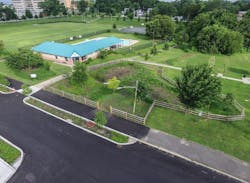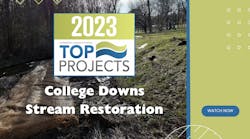Keisha Brown is partnership liaison for Corvias. Brown can be reached at [email protected]. Sean Agid is partnership catalyst for Corvias. Agid can be reached at [email protected].
undefinedStorm water runoff and its impacts to communities nationwide, as a result of flooding events, drainage issues and increased pollution of local and regional waterways, have been an ongoing challenge for decades. Now, as climate change continues to amplify the intensity of extreme weather events, municipal managers and public officials are now finding ways to address their storm water funding questions, presumably with the community in mind.
Operators of National Pollutant Discharge Elimination System (NPDES) Municipal Separate Storm Sewer Systems (MS4) permits, through their storm water management programs, are working to address and improve water quality, reduce storm water runoff and satisfy compliance requirements but are often met with hurdles that include funding, procurement and community-buy in. Historically, storm water programs are underfunded. There are competing priorities and budget constraints that lead many in the public sector to reconsider the benefits and advantages of working collectively with neighboring municipalities to form regional storm water management programs. There are also considerations to tap into the private sector to evaluate, develop and implement programs, such as community-based public-private partnerships (CBP3) that support them in meeting their regulatory compliance requirements inclusive of co-benefits to members of the community, making community buy-in an easier lift.
Funding storm water infrastructure improvements is typically the center point of discussions when evaluating and developing strategies for the development and construction of storm water retrofits and installations. Multiple funding and financing sources, such as private financing, storm water utility fees, grants and low interest loans are available options for permit holders to evaluate for use as part of their overall strategy for infrastructure improvements. Traditionally, storm water infrastructure tends to be done piecemeal and financed on a project-by-project basis, and projects are distributed and geographically disbursed. However, two municipalities in the mid-Atlantic region have leveraged State Revolving Fund Loans as financing mechanisms at a programmatic level to accelerate the development and construction of storm water improvements in their jurisdictions under a CBP3 approach.
Observing Prince George’s County, Maryland
Prior to the development of the Clean Water Partnership (CWP) in 2015, its community-based public-private partnership with Corvias, Prince George’s County, Maryland, had multiple challenges at hand in meeting its Clean Water Act compliance requirements to reduce storm water runoff and pollution. To meet compliance, the county faced complex implementation and maintenance challenges of existing and new storm water infrastructure but didn’t have a large enough network of storm water contractors capable of meeting the stringent regulatory requirements. Additionally, the county needed an affordable way to finance the design and implementation of hundreds of distributed storm water projects necessary to meet compliance.
Each year the Maryland Department of Environment (MDE) actively solicits “green” projects to be included in its Water Quality Revolving Loan Fund Program, also known as the Clean Water State Revolving Fund (SRF), to help restore Maryland’s waterways as part of the larger Chesapeake Bay restoration goals. This fund provides below-market rate loans to catalyze capital investments in water projects, in accordance with the Federal Clean Water Act and is aligned well with the mission of the CWP.
Through the CWP, Prince George’s County Department of Environment Protection (DoE) has been awarded $130 million in low-interest rate loans and $1.5 million in principal forgiveness grants by the fund. The State Revolving Fund loans include the planning, design and construction of projects completed by the CWP. To-date, 160 projects have been completed across the county in every council district, which generate co-benefits centered on community engagement and education, contractor capacity development and mentoring of local, small and disadvantaged businesses.
Looking at the Stormwater Authority of Chester
Another example of the utilization of funding administered by a state is in the city of Chester, Pennsylvania, through the Stormwater Authority of Chester (SAC) community-based public-private partnership. The Stormwater Authority of Chester is a municipal authority created to reduce storm water runoff and pollutants entering the Delaware River and local waterways and address localized flooding challenges. The city experienced decades of underinvestment in infrastructure and needed an affordable solution to tackle both deferred maintenance and regulatory requirements. Given the steady declining tax base in the city since the 1960s, the funding available for the authority presented a challenge to its mission.
The Pennsylvania Infrastructure Investment Authority (PENNVEST) has been a strong partner to the authority. With support of the EPA region 3, PENNVEST provided the authority a $1 million grant to structure the community-based public-private partnership and implement a storm water utility fee to serve as a long-term funding source for the authority. Once the funding source was in place, the authority worked with PENNVEST and Corvias to structure financing to accelerate the investment within the city. To-date, PENNVEST has awarded $34 million in low interest rate loans through the State Revolving Fund to the Stormwater Authority and, most recently in January 2021, a nearly $10 million grant to address localized flooding in the Veteran’s Park area of the city, improving water quality and addressing critical safety hazards caused by residential flooding. The loans are paid back through the storm water utility fee over a 20-year period after construction and repair is completed.
Municipalities today have multiple options to fund and finance the implementation of storm water management programs, despite competing priorities and infrastructure needs. Community-based partnerships can leverage funding provided by the state in support of much needed water quality and flood management improvements. Each municipality has different needs, goals and objectives and should evaluate funding and financing options available. However, all 50 states currently offer access to a Clean Water State Revolving Fund that can provide subsidized financing and/or grants that can be used for the implementation of storm water infrastructure. Other options available to municipalities, such as the Water Infrastructure Financing Innovation Act (WIFIA), are available for larger projects and provides flexibility around structuring the repayment.
The ultimate benefactors of this funding are stakeholders and members of the community, who in the case of the two community-based public-private partnerships highlighted above, reap the benefits of green infrastructure improvements constructed in their neighborhoods. The added community capital in allowing for partners to educate and inform the greater public on storm water management and the importance of simple activities that can reduce pollution to water is extremely beneficial.
In terms of local, small and disadvantaged businesses who now have access to contractor development and mentoring opportunities, this can be a continuing benefit to expand expertise in various facets in the storm water management and green infrastructure areas while also allowing business owners to improve the communities in which they live and work. Regardless of the source, a key component is to aggregate distributed projects at a programmatic level to reduce the frictional and transactional costs associated with financing the projects. This will also help accelerate the investment in storm water maximizing the benefit to the community.






